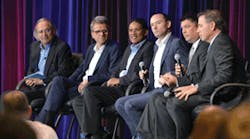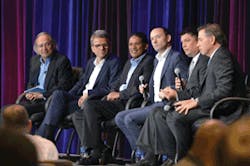More than a few brains are getting scrambled as the process control industries make their often tangled journey from hardware and old-style networking and software to the increasingly digitalized world of Ethernet, servers, the cloud, the Industrial Internet of Things (IIoT), big data, virtual devices, machine learning, artificial intelligence and all their trendy derivatives.
The executive panel on the second day of ARC Industry Forum 2018 on Feb. 13 explored how to improve their operations with innovative processes and technologies. Participants included (l. to r.) Andy Chatha of ARC; Peter Terwiesch of ABB; Kenny Warren of ExxonMobil Research and Engineering; Peter Herweck of Schneider Electric; Jason Handley of Duke Energy; and Antonio Pietri of AspenTech.
Source: ARC
One of the few guiding lights through this maze comes from the presenters, users, analysts and suppliers, who tackled these issues at ARC Advisory Group's 22nd Annual Industry Forum on Feb. 12-15 in Orlando, Fla. Approximately 900 visitors took in 50 keynotes and other conference sessions in six tracks, where they gained useful insights in how to understand, thrive and help others succeed in their newly digital environments.In the event's first keynote address, Kenny Warren, vice president of engineering at ExxonMobil Research and Engineering Co., updated the audience on parallel efforts by the Open Process Automation Forum (OPAF), ExxonMobil, Lockheed Martin and many other users, system integrators and suppliers to develop the OPA standard specifying the interfaces for an open and interoperable process control system. He also detailed how ExxonMobil is proceeding with its own OPA proof of concept and upcoming field trials.
In the second keynote, Jason Handley, PE, director of smart grid technology and operations at Duke Energy Corp., reported that, "Customers want more choice and control, so we're driving intelligence to the edge of the grid. The cornerstones of this effort are cybersecurity and advanced analytics, which enable us to provide individualized customer experiences, smart metering, and modernize our power grid.
"However, many of these power and communications systems can create a real hairball of complexity, especially as they evolve. So, to build a smarter energy future for our customers and us, we investing about $10 billion over the next five years, with about two-thirds going to a more reliable system, and one-third going to a smarter grid."
Handley explains that Duke Energy believes there are six main pillars of digitalization:
- Product innovation with design thinking, design sprints, software engineering and agility;
- Analytics with data science, Hadoop, SAP Hana and visualization;
- Data with information platforms, governance, virtualization and a data dictionary;
- Modern architecture with an API factory, cloud native design and service orchestrations;
- User experience (UX) platform with mobile app development and more web user interfaces; and
- Automation with robotic process automation, cloud native infrastructure and code automation.
"It will be useful if a robotic device in a substation or more distributed intelligence can tell us what's going on," says Handley. "At the same time, we also need better cybersecurity, but virtualized devices can help isolate and protect our systems from threats, too."
In other news at the ARC Industry Forum, a variety of innovations, solutions and services were introduced, including:
- Emerson reported that it's expanding its Plantweb digital ecosystem by launching its DeltaV version 14, which is a cybersecurity-certified control system designed to deliver new value in capital projects, and make plant operations more connected and productive. This latest release provides innovations to the entire DeltaV architecture, and was built with users' digital transformation initiatives in mind. In addition, Emerson and AspenTech announced that they've teamed up to deliver asset optimization software solutions along with global automation technologies and operational consulting services. Together, the two companies report that they'll help customers optimize production and drive operational excellence.
- Stratus Technologies unveiled its ztCEdge software, which is a zero-touch, fully virtualized, self-protecting computing platform for industrial edge environments. Because it has built-in remote management and is user-installable in less than an hour, ztCEdge reportedly reduces the IT burden for virtualized computing at the edge.
- Inductive Automation launched its Ignition Onboard program, which lets device manufacturers embed its Ignition and Ignition Edge software in the devices they manufacture. So far, Opto 22, Advantech B+B SmartWorx, Hilscher, Moxa and EZAutomation report that they're are adding Ignition Edge to their products. Also, KEBA, Brown Engineers, Azul Systems, Nexoforge and Tyrion Integration are embedding the full version of Ignition.
- L&T Technology Services Ltd. reports it's developed a cognitive intelligence framework called AiKno that combines contextual intelligence and AI, enabling users to develop digital virtual agents, problem-solving applications and robotic process automation. AiKno uses technologies such as advanced image processing, optical character recognition (OCR), natural language processing (NLP) and self-learning AI algorithms. As a result, its cognitive engine begins to self-learn from the data and information it extracts, and its accuracy keeps getting better over time as a larger set of domain knowledge is fed to the system.
- HIMA presented its comprehensive functional safety concept that offers maximum security by expanding the scope from the safety instrumented system (SIS) to its security-relevant environment, and explained why plant operators should implement a holistic functional safety approach that ensures plant security in times of increasing cybercrime. By complementing the SIS with the “HIMA Security Environment for Functional Safety,” the company reports its approach takes all important, security-relevant aspects of industrial control systems (ICS) into account, which include five areas: controller hardware and firmware, engineering toolkit, PC infrastructure, communication infrastructure and lifecycle management.
- Yokogawa Electric Co. released its Operations Management software for recording and managing data on the work performed by plant personnel. The company reports it developed this solution as part of its customer-driven Operational Excellence Transformation, which is an expanded offering of consulting and solution services for optimization supply chains and operations. Yokogawa plans to release a mobile version of this software in June.
- Opto 22 released its groov EPIC system that combines I/O, control, data processing and visualization into one secure, maintainable, edge-of-network industrial system. groov EPIC lets engineers and developers focus on delivering value, not on triaging loosely connected components. It combines reimagined intelligent I/O with an embedded Linux real-time controller, gateway functions, and an integrated display.





